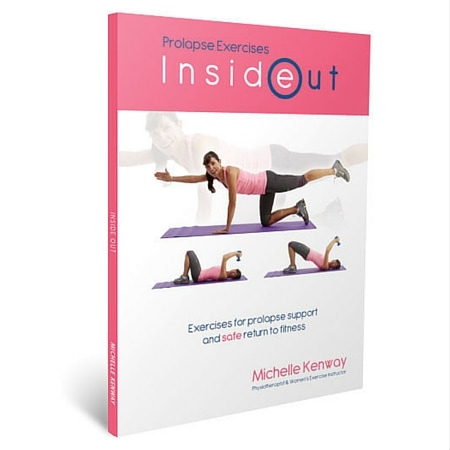
Knowing what causes prolapse after childbirth can help you manage your prolapse and reduce your risk of prolapse worsening.
Read on now to learn:
A. What causes prolapse after childbirth?
B. Manageable causes of prolapse to avoid prolapse worsening
A. What Causes Prolapse After Childbirth?
One of the main causes of prolapse after childbirth is damage to the supporting pelvic floor muscles and tissues.
This damage makes the postnatal pelvic floor more vulnerable to prolapse.
Prolapse Exercises e-Book
International best selling prolapse exercise guide for women with prolapse and after prolapse surgery.
Prolapse Exercises teaches you how to:
- Exercise safely after prolapse surgery
- Reduce your risk or repeat prolapse
- Avoid unsafe exercises
- Choose pelvic floor safe exercises
- Reduce your risk of prolapse worsening
- Improve prolapse support
- Increase your strength and fitness
- Strengthen your core
- Lose weigh
Permanent injury to the pelvic floor occurs when the tissues are overstretched or torn during delivery. Sometimes the pelvic floor muscles are torn completely off the pelvic bones (levator avulsion).
1. Vaginal delivery
Vaginal delivery is a major cause of prolapse after childbirth.
Pregnancy and vaginal delivery stretch and weaken the pelvic floor muscles and tissues that support the vagina. Some vaginal deliveries cause significant damage to the pelvic floor supports.
Caesarean delivery has not been associated with an increased risk of pelvic organ prolapse.
2. Number of Deliveries (Parity)
A single vaginal delivery increases the risk of prolapse. Most of the damage to the pelvic floor usually occurs during the first delivery during bearing down as the baby’s head descends and passes through the birth canal.
The risk of vaginal prolapse increases with increasing number of vaginal deliveries.
 3. Instrumental Vaginal Delivery
3. Instrumental Vaginal Delivery
Obstetric forceps deliveries are one of the major causes of prolapse after childbirth. Both forceps or vacuum extraction procedures can stretch, tear and permanently damage the pelvic floor.
4. Large Birth Weight Baby
Delivering a large baby can cause pelvic floor trauma and permanent damage. Babies greater than 4kg (8lb 13oz) are known to increase the risk of prolapse after childbirth.
5. Maternal Age
The age of the mother at childbirth can increase the risk of prolapse after childbirth. The pelvic floor changes and weakens with increasing age which is why more mature women have an increased prolapse risk.
B. Manageable Causes of Prolapse
Knowing these manageable causes of prolapse can help you reduce your risk of prolapse worsening.
1. Obesity
Being overweight is a risk factor for prolapse. The pelvic floor supports the weight of the abdominal organs. This is why the load and strain on the pelvic floor is increased when these organs are covered in fat.
Managing your body weight after childbirth is an important step you can take to reduce your risk of prolapse after childbirth or prolapse worsening.
 2. High Impact Exercise
2. High Impact Exercise
High impact exercise involves both feet off the ground at the same time and landing heavily. This type of exercise can overload and strain the pelvic floor, potentially worsening prolapse issues.
This is why high impact exercises such as running and jumping should be avoided after childbirth until the pelvic floor is fully recovered.
Women who sustain prolapse immediately after childbirth need to carefully consider whether they ever return to high impact exercises. If you have a prolapse or if you’re at increased risk, choose appropriate low impact exercises such as brisk walking or cycling.
3. Chronic Coughing
Coughing forces the pelvic floor and prolapse downwards. Repeated coughing stretches and weakens the pelvic floor, increasing the risk of prolapse and worsening a prolapse if it already exists.
Causes of coughing include:
- Smoking
- Chronic Bronchitis
- Asthma
- Allergies
If your risk of prolapse is increased, avoid smoking and try to manage any condition that causes coughing. For example if you have an acute episode of bronchitis speak with your medical caregiver about using a cough suppressant.
4. Constipation and Straining
Chronic straining to empty the bowels with constipation is a major cause of prolapse. Some women first notice their prolapse after straining to empty their bowels.
Manage constipation and avoid straining after childbirth:
- Use the correct bowel emptying position and technique
- Keep the correct stool consistency by
– using a stool softener as required
– adhering to appropriate diet to manage your bowels.
Understanding what causes prolapse is the first step to better prolapse management. Avoiding or minimising the manageable risk factors for prolapse after childbirth can help you minimise the risk of your prolapse worsening over time.
Further reading:
» How to Treat and Manage Your Prolapse after Childbirth
» What Dr Google Never Told Me About Prolapse After Childbirth




 3. Instrumental Vaginal Delivery
3. Instrumental Vaginal Delivery 2. High Impact Exercise
2. High Impact Exercise

